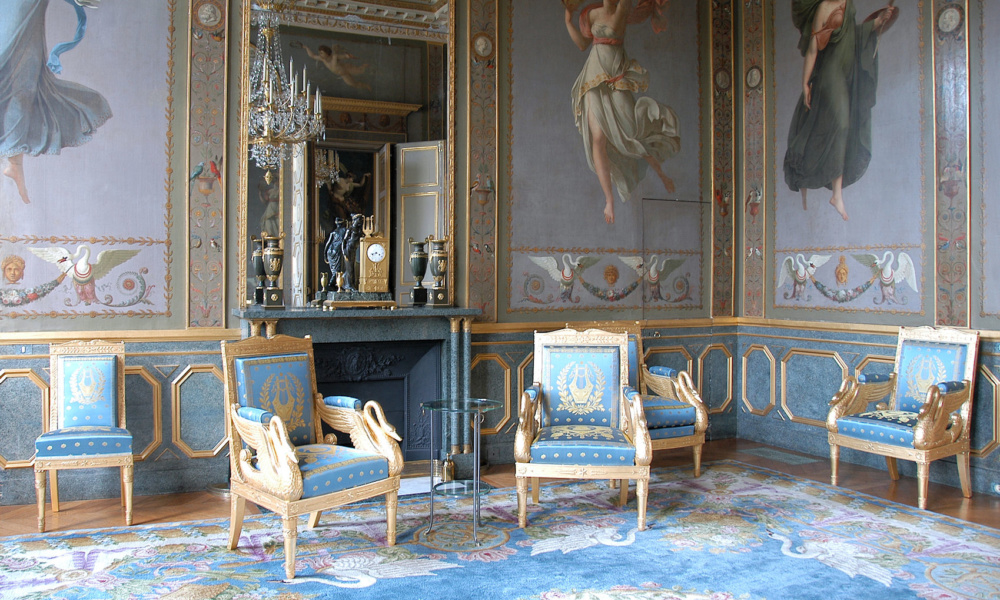The restoration of furniture as understood today is different to that practised in the previous century and even more different to that of the preceding centuries. Through a brief history, the author retraces the evolution in mentalities, its causes and consequences.
La revue Experts n° 56 – 09/2002 © Revue Experts
The restoration of works of art has considerably changed over the second half of the 20th century. In relation to furniture, the subject of discussion in this article, the current rules help both the expert and the court in resolving certain conflicts. The work habitually carried out in the 17th or 19th centuries is not conceivable nowadays and should be condemned.
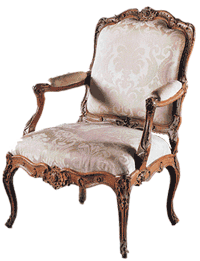
Suite of six armchairs in natural wood attributed to Jean Avisse sold in Monaco on 13 December 1997 by the Sotheby’s auction house. Originally covered with a primer (whiting and animal glue), the armchairs were stripped in the second half of the 19th century.
The inalienable ‘author’s right’ that artists hold has an influence in the restoration of works of art. Who today has the right to alter an item of furniture from the 18th century in order to ‘improve it’ to his taste? The concept of authors’ rights, associated with an increasing tendency to carry out research for the purposes of determining historical verity, tends to remove restorations and renovations that alter the work, such as changing the bronze trimmings of a commode or revarnishing a scratched desk.
The idea of a minimalist intervention by the restorer, as practised on major works of art such as paintings and sculptures, is spreading to furniture. With this concern in mind and aided by the reversible results of consolidation, cleaning (solvants) and gluing, restorers protect as much as possible of the item of furniture that has suffered the ravages of time.
The restorer of today is a professional who guarantees not only a level of knowledge but also the transmission of an asset and must restrain exactions demanded by certain clients. He therefore privileges a protective measure (for example, fumigation against xylophage insects, consolidation using Paraloid, filling an inset with a paste) that are reversible and will not alter the percentage of authenticity of the object.
1. History of restoration
We do not have any examples of the restoration of furniture carried out in ancient times. The first known restorations were to sculptures, citing, for the record, the Romans’ taste in Greek art and the modifications that marble sculptures were subjected to in order to be exhibited in cities and palaces.
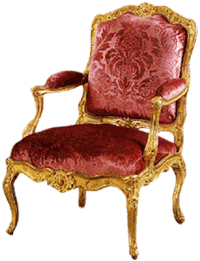
The professional, as purchaser, has had them restored according to the current trend in the art market by restoring their original primer aspect. The gilding, the finish and the patina that were expertly applied are misleading. Exhibited at the antique dealers’ biennial at the Carrousel du Louvre, more than one expert thought it was an ancient gilded piece that had been restored. The nuance is important.
In France, the Renaissance then the 17th century witnessed the same improper demands. The Louis XIV Galerie des Antiques in Versailles comprises numerous Greek and Roman heads inserted onto modern busts in polychrome marble with reconstituted broken noses or ears.
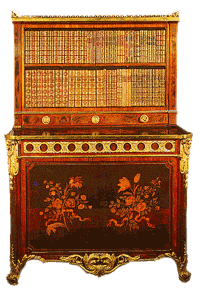
On 6 June 1976, this item of furniture went up for sale in the Galliera Palace in Paris with the following caption: “important writing desk in veneered wood,… In the middle section, three small drawers and a panel with inlaid medaillon: Michel de Montaigne 1592, bookbindings, mathematical instruments and bouquets of flowers.”
Attributed to R.V.L.C. (Roger Van der Cruz, known as Lacroix).
Originally, the upper and lower parts of this desk opened with sliding panes that were transformed into doors.
Decorative furniture was considered to be a minor art.
Kept in good condition when it was fashionable, it was relegated to secondary residences then abandoned to domestics when permitted by financial resources. Only exceptional pieces, through the richness of their decoration or their inlays in hard stones, for example, imported from Italy in the Renaissance, were sometimes reused.
Under the Ancien Régime, furniture enabled the lifestyle of its owners to be displayed (to understand its importance in the minds of the French in the 17th and 18th centuries, it can be compared with the image produced by the car in the 20th century, which reflects a certain financial affluence according to the make and model).
The nobility sought out cabinetmakers and handcraft merchants (retailers of furniture and works of art who were also decorators) that were in favour with the king, because from Louis XIV to Louis XVI, through Marie-Antoinette, the creations came from Versailles. Large houses had their own artisans for maintenance. It was not conceivable that the gilding, which wore out rapidly on chairs, for example, should not be renewed; idem for the tapestries and other works of art.
In the 18th century, the fashion cycles increased: end of the reign of Louis XIV, the Regency, the reign of Louis XV, which incorporated two styles (posterity would call them ‘Louis XV style’ and ‘Louis XVI style’, called ‘modern style’ at the time), without forgetting the fashions favoured by Madame de Pompadour and Madame du Barry, then the reign of Louis XVI when Marie-Antoinette substantially influenced the production of furniture that was elegant, light and very finely decorated.
The 19th century, rich in historic upheavals, also contained a variety of ornamental themes: Egypt, the Middle Ages, Renaissance then the 17th and 18th centuries became sources of inspiration for interior decoration.
In the middle of the 20th century, the concept of standard maintenance slowly evolved towards ideas of conservation and restoration.
Due to its importance, the Palace of Versailles is today a perfect example of the trends in the successive ideas that are associated with restoration, from mutilation to minimalist intervention.
Abandoned for more than forty years after the reign of Louis XVI, the Palace was ‘restored’ by Louis-Philippe. The central body maintains part of its historical integrity: the apartments in the wings that housed the princes were demolished, being replaced to the north by the Gallerie de Pierres and rooms covering the crusades era and the conquest of Algeria, boasting the Battle of the Abd El-Kader Smala by the Duke of Aumale, son of Louis-Philippe. All of the apartments on the upper floor of the south wing were demolished to build a large gallery, with huge paintings covering the walls retracing the major battles in the history of France from Clovis to Napoleon I.
The royal apartment became a museum dedicated to all of the glories of France.
It was not until the 1970s that the royal apartments (not destroyed to maintain the propoganda of the July Monarchy) were altered to remove what had been added in the 19th century and, after a restoration that very closely followed historical verity, return to a state that, while not complete, was very close to that of the 18th century.
The reigns of Louis-Philippe then Napoleon III were those of architectural restorations mainly by the reputed architect, Viollet-le-Duc, whose work can be seen in Carcassonne, at the Notre-Dame in Paris, the Vézelay Abbey, the Château de Pierrefonds… Such work also included interior designs, the trend being to use dark, austere, woods: the magnificent woodwork covered in polychromy in the Louis XV salons in the Château de Rambouillet were stripped to reveal the colour of waxed oak, those ‘golden age’ items that were entirely reinvented at the Château de Pierrefonds were left in natural waxed wood.
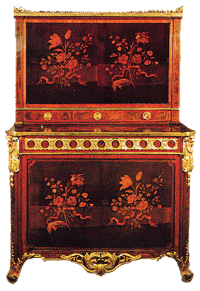
One year later, in October 1976, this same piece was presented at the Antique Dealers’ biennial with the upper doors resembling the lower doors through a montage produced with the previous photograph. It was presented in the catalogue as being a “filing cabinet with panels by J.H. Riesener”. It opens via the four panels inlaid with bouquets of flowers…
No mention of the prestigious trace of the stamp is contained in the caption.
The major architectural restorations of the 19th century set the tone, to be followed by the furniture restorers. The restoration of personal property flourished under this theatrical design.
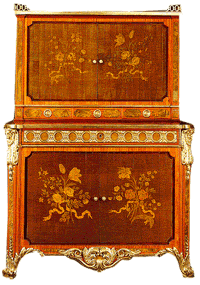
In February 1993, we find the piece now with the four panels transformed into four vertical-sliding screens, the lower inlays inversed… It is described as being a “secretary bench” “Marquetry signed and dated in the upper right of the trophy: ‘Riesener fecit 1771’”. Stamped ‘J.H. Riesener’. Three full pages were barely enough to describe this “secretary bench (that) is one of the rare items of furniture, certainly one of the last, on which the cabinetmaker to the king used large, thin-strip, sliding panels”.
Artisans who had acquired a perfect mastery of trades, partly through the guild system, could complete or reproduce all works from the preceding centuries. When a leg was worm-eaten, they did not hesitate to replace it with a new leg… If a piece that was a pair had suffered substantial damage, it was replaced by a copy. Often, the hand was overly influenced by the technique and produced only pastiches that lacked the sensitivity and charm of the previous decorative arts.

The late discovery of the signature in the inlay in the upper right of the trophy above of the inscription Michel de Montaigne 1592 raises certain questions.
Fortunately, from the middle of the 19th century and with the end of the last French monarchy, the penniless nobility left numerous chateaux in states of neglect. No longer having any important role, they faded into the background, maintaining intact their decors and furniture from the past that were sheltered from the ravages of fashion trends.
At the same time, the rise of the bourgeoisie, avid for social recognition, profited from new decorative trends that borrowed their vocabulary from both previous French centuries and Islamic and oriental decorative arts. These pastiches took precedence until the end of the First World War.
Only some erudites such as the collectioners Georges Hoentschel, the banker de Camondo or Sir Wallace understood, from the 1970s, the importance of protecting the still numerous vestiges of furniture from the 17th and 18th centuries without altering them.
It was not until peace had been restored after the Second World War that the concepts of conservation and restoration were clearly defined.
The second half of the 20th century is the culmination of ideas developed in institutions in London and Rome in the 1930s. The European restoration institutions organised conferences codifying the uses and limits of conservations and restorations.
In France, the Restoration Laboratory in the Louvre worked in concert with the École du Louvre then the university (MST: masters in sciences and techniques at Paris IV for the conservation and restoration of works of art). The outcome of this policy was the creation of the French Institute of Restoration of Works of Art (IFROA in French) in Paris in 1982.
In practice, the new ideas were applied mainly in public institutions, the students becoming conservators and restorers in museums or restorers of objects.
Nowadays, the art market is essentially still private as neither the national museums nor the State supervised museums or institutions can sell their collections of works of art. Of note was a certain desire by antique dealers associations at the end of the Second World War to improve the restorations market by restricting to 30% the reconstitution percentage of an antique item of furniture. That decision tackled the too numerous restorations that allowed the cabinetmaker to multiply authentic chairs and console tables…

Detail of ‘the stamp’.
2. The scientific contribution in the second half of the 20th century
The concepts of conservation and restoration became established after the Second World War due to scientific contributions that can be divided into three sectors:
|
|
|
|
|
Les principes de réversibilité furent défendus et instaurés ainsi que ceux de la restauration minimaliste.
The principle of reversibility was established and defended, as was that of minimalist restoration.
At the beginning of the 21st century, such advances were understood in the museum world but not yet taken onboard by the art market. The reason was simple: that sector of activity, being commercial, was still too dependent on its own habits and profits.
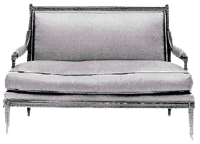
Sofa, part of a suite together with four armchairs, stamped L.M. Pluvinet, who became a master cabinetmaker in 1773. Sale at Sotheby’s in Monaco on 15 June 1981, 136 cm wide.
To announce that 30% of an item of furniture has been restored does not encourage its sale and requires an in-depth and costly study. An ‘orphan’ armchair, even exceptional, has little value compared with the same transformed into a pair ‘of that era’; idem for a (four-seater) sofa modified to become a pair of marquise chairs (two times two places) or for an upright three-door secretary to be decorated with a lacquer or inlay of flowers or other objects.
A common item of furniture as so modified can see its value increase substantially if the modifications are neither announced nor revealed by an expert.
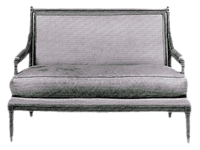
Sold again on 30 June 1986 at the Hotel Drouot, the “attractive suite of four armchairs” has not changed but the sofa has been reduced 5 cm in width, the tissue being new.
3. Unreasonable modifications
What is the limit between unreasonable modifications, fraud and error in the essential qualities of an object?
Does the 30% restored portion (in the sense of an identical reconstitution agreed to by the antique dealers) correspond to a surface area or a volume? Can a bust portrait the whole face of which is reconstituted still be considered to be authentic even though the surface area of the work does not exceed 20%?
While the art trade flatters itself in having saved numerous works of art from ruin through its interventions (cleaning, restoration and historical research), it must, however, rigorously follow the ethical rules applying to restorations that are highlighted by European restoration institutes and restoration associations. The situations referred to below more frequently end up in court.
3.1. Restorations that do not comply with standard professional techniques
For example: an item of furniture from the 18th century, the veneer and assembly of which were glued using a strong glue that becomes unstuck with heat (nerve glue mixed with bone glue prepared in a bain-marie) are reglued with non-reversible glues such as epoxy. While the use of these modern glues significantly reduces the amount of time taken by the restorer, after several years the furniture can no longer be restored and the synthetic resin accelerates the damage to the wood.
3.2. Restoration of gilding using bronzine
The restoration of gilded wooden mirror frames, console tables and chairs using bronzine (bronze or aluminium powder mixed with a varnish or wax) is also more rapid and less costly that a restoration using gold leaf. Again, however, this is cosmetic work that satisfies amateur art lovers only for a relatively short period of time (the time for exhibition for sale) as this powder oxidizes over time and blackens, its aspect no longer becoming tolerable, and the required restoration work is very costly.
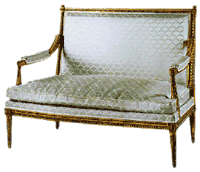
On 26 June 2002, it is again presented for auction at the Hotel Drouot, still stamped L.M. Pluvinet. The ‘trianon grey’ lacquer has been replaced with a golden patina that has already deteriorated. The upholstery and tapestry work have been changed. The width is reduced to 109.5 cm, namely 26.5 cm less than the original.
3.3. Restorations that ‘enhance’ the proportions and the structure
The transformation of a veneer through the addition of an inlay representing a currently trendy motif and the changing of drawers into doors or doors into a screen are also frequent.
Bronze ornaments are also very often subject to modifications.
The prices increase according to the richness of the decoration and their rarity (and their source and the cabinetmaker, but this aspect has already been raised in a previous article on stamps). It is not to be excluded that an owner requests some alterations from his cabinetmaker at the time of the restoration.
A Louis XVI sofa may thus separated into two wing chairs or a suite of chairs in natural wood become gilded ‘from origin’.
It is interesting to note that the restorations carried out using current practises or in an unreasonable manner are never listed in auction catalogues and on antique dealers’ invoices. Significant vagueness surrounds the terms used, such as: ‘standard restoration’, ‘some parts restored’…
With the exception of some pieces of furniture of historical interest, a precise study that includes all work carried out in the 19th or 20th centuries is never proposed to the future purchasers, not been justified for the purposes of the sale, but is produced only for owners who are persuaded that their piece holds significant interest.
The concerns come from the purchaser who, when the piece of furniture is considered suitable for a museum, wants to better understand it and value it through the production of a full technical report. If he discovers that the bronze decoration is not original, that the beautiful still life on the exotic wood veneer is recent or the superb 18th-century gilding was added several months before he bought it in the 18th Arrondissement, he has the feeling of having been duped and, logically, demands compensation for his loss.
The appointed expert must then, with considerable tact, provide clarifications to the judge on the facts and standard practices and avoid issuing any judgment. Reasons must be given for his opinion and it must be supported by irrefutable technical proof in order to remain above the battle of the experts that will undoubtedly follow.
